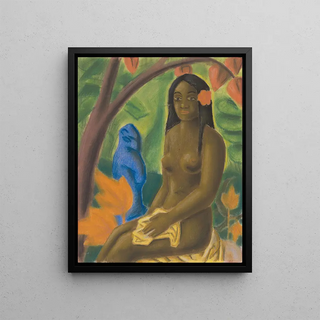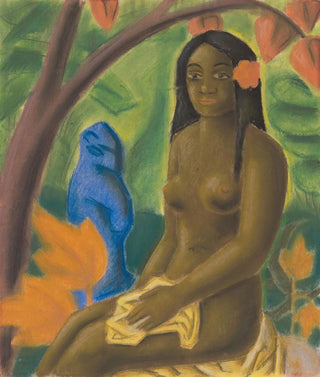Art print | Tahiti Girl - Mikuláš Galanda Source: Reproduction | Fille de Tahiti - Mikuláš Galanda


View from behind

Frame (optional)
Art print Fille de Tahiti - Mikuláš Galanda – Captivating introduction
The canvas "Fille de Tahiti" by Mikuláš Galanda is a work that transcends the simple frame of painting to immerse the viewer in a vibrant universe, where beauty and exoticism blend harmoniously. This piece, emblematic of the modernist period, evokes not only the artist's fascination with distant landscapes and cultures but also a quest for authenticity and sensitivity. By inviting us to contemplate this representation of a young Tahitian woman, Galanda transports us to the heart of an island where time seems suspended, where vivid colors and fluid shapes dialogue with light in an almost hypnotic manner.
Style and uniqueness of the work
Mikuláš Galanda's style is characterized by a rich and bold color palette, where warm tones of the ocean and tropical vegetation intertwine to create an enchanting atmosphere. In "Fille de Tahiti," the artist demonstrates exceptional mastery of light and shadow play, giving his subject a depth and an almost sculptural dimension. The way he captures the delicate features of the young woman, as well as the fluidity of the natural movements surrounding her, reflects a sensitivity to feminine beauty and nature that transcends cultural boundaries. Every brushstroke seems charged with emotion, inviting the viewer to feel the warmth of Tahitian sun and the gentle ocean breeze.
The artist and his influence
Mikuláš Galanda, a painter of Slovak origin, managed to establish himself on the 20th-century art scene thanks to his unique style and innovative approach to painting. Influenced by modernist currents and artists of his time, he developed a voice that is entirely his own, blending Eastern and Western influences. His passion for exploring diverse cultures led him to focus on exotic themes, as exemplified by "Fille de Tahiti." Galanda also played a key role in redefining Slovak art by incorporating elements of popular culture and engaging in artistic dialogues that

Matte finish

View from behind

Frame (optional)
Art print Fille de Tahiti - Mikuláš Galanda – Captivating introduction
The canvas "Fille de Tahiti" by Mikuláš Galanda is a work that transcends the simple frame of painting to immerse the viewer in a vibrant universe, where beauty and exoticism blend harmoniously. This piece, emblematic of the modernist period, evokes not only the artist's fascination with distant landscapes and cultures but also a quest for authenticity and sensitivity. By inviting us to contemplate this representation of a young Tahitian woman, Galanda transports us to the heart of an island where time seems suspended, where vivid colors and fluid shapes dialogue with light in an almost hypnotic manner.
Style and uniqueness of the work
Mikuláš Galanda's style is characterized by a rich and bold color palette, where warm tones of the ocean and tropical vegetation intertwine to create an enchanting atmosphere. In "Fille de Tahiti," the artist demonstrates exceptional mastery of light and shadow play, giving his subject a depth and an almost sculptural dimension. The way he captures the delicate features of the young woman, as well as the fluidity of the natural movements surrounding her, reflects a sensitivity to feminine beauty and nature that transcends cultural boundaries. Every brushstroke seems charged with emotion, inviting the viewer to feel the warmth of Tahitian sun and the gentle ocean breeze.
The artist and his influence
Mikuláš Galanda, a painter of Slovak origin, managed to establish himself on the 20th-century art scene thanks to his unique style and innovative approach to painting. Influenced by modernist currents and artists of his time, he developed a voice that is entirely his own, blending Eastern and Western influences. His passion for exploring diverse cultures led him to focus on exotic themes, as exemplified by "Fille de Tahiti." Galanda also played a key role in redefining Slovak art by incorporating elements of popular culture and engaging in artistic dialogues that






